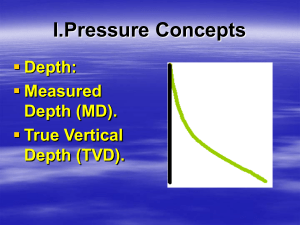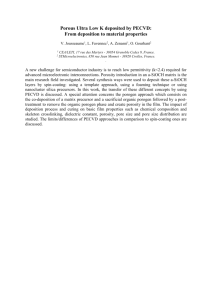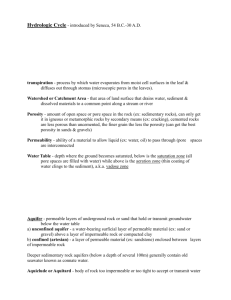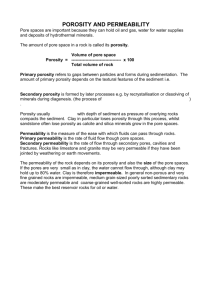Formation Pressure
advertisement
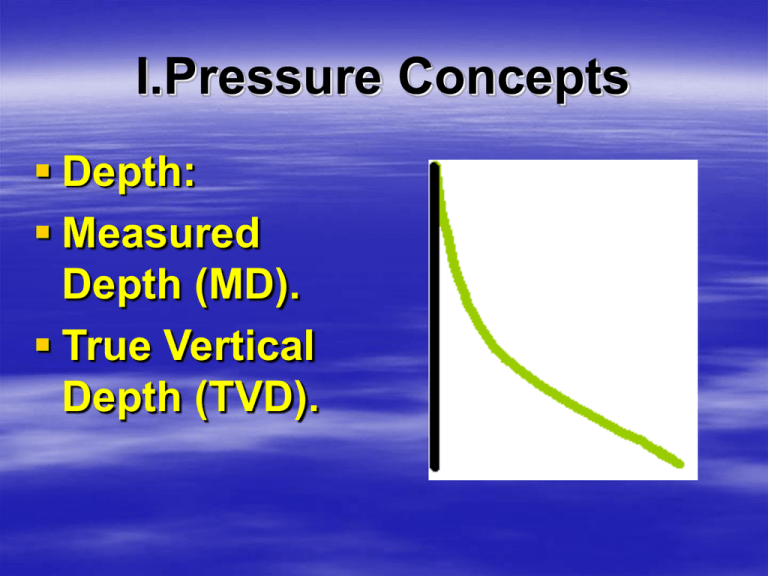
I.Pressure Concepts
Depth:
Measured
Depth (MD).
True Vertical
Depth (TVD).
I.Pressure Concepts
Force:
((Force = Mass X Acceleration))
DENISTY:
((= Mass (or Weight) Per Unit Volume))
Pressure
•
•
•
•
•
•
((Is an Expression of Force Per Unit Area))
Hydrostatic Pressure.
Frictional Pressure.
Annulus Pressure.
Well Bore Pressure.
Differential Pressure.
Bottom Hole Pressure.
Pressure Concepts
Balance:
((Refer to the Relation Between the
Formation Pressure and the
Hydrostatic Head))
Balanced.
Under Balanced.
Overbalanced.
II.ROCK PROPERTIES
Porosity.
Saturation.
Permeability.
Overburden.
Formation pore pressure.
Compaction.
Matrix stress.
1. Porosity
Matrix
Pores
Porosity= Pore Space Volume
Bulk Volume.
Porosity Generations
Primary porosity:
• HPP
40%.
• At 10000’, shale porosity
reaches
5%.
Secondary porosity:
• Those ones created after initial
deposition.
• Either by dissolving or
fracturing.
2. Saturation
• Is that fraction of pore volume that is
filled with a given fluid.
• A 20% sw = 20% of the pores are filled
w/ water & 80% w/ other fluid which may be
oil or gas.
3. PERMEAPLITY
• Is a measure of the ease with which a
fluid will flow through a formation.
• Q= k*a* (p1 – p2)/v*l.
• K = QVL/A(P1-P2) in millidarcies.
• The larger the porosity the higher the
permeabilty.
4. Overburden
• Overburden load:
Is the combined weight of the formation
matrix and the fluids overlying a
formation.
• Overburden pressure:
Is the pressure exerted by the
overburden load upon underlying
formations.
Compaction
It is PRINCIPALY a process of
mechanical rearrangement
Factors Affecting Compaction
Rate
1.
2.
3.
4.
5.
6.
Rate of deposition.
Tectonic forcess.
Formation permeability.
Lithology.
Diagenesis.
Osmosis.
Overburden
Overburden
pressure
Matrix Stress
Pore Fluid
Pressure
Matrix Stress
Is the resistance of the formation
matrix to compaction expressed in
psi or psi/ft.
Overburden Gradient
This is an expression
of the pressure unit
per unit depth. e.g.
• psi/ft.
• ppg..
5.Formation Pressure
((Is the Fluid Pressure Found Within
the Pore Spaces of the
Formation))
•
Can Be Expressed As an Average
Vertical Pressure or Equivalent Mud
Weight. E.G. psi, ppg, G/cc…
Normal Pressure
Matrix
Pores
Expelled fluid
Normal Pressure
equal
Formation pressure
in
magnitude to the hydrostatic pressure of
a column of pore fluid that reaches from
the surface to the vertical depth of the
formation.
Abnormal Pressure
Matrix
Pores
Abnormal Pressure
greater
Formation pressure
than
the magnitude of the hydrostatic
pressure of a column of pore fluid that
reaches from the surface to the vertical
depth of the formation.
1.Concept of Continuous
Deposition
This concept assumes that the compaction
rate of any formation is the same as for all
formations of a given type.
This mean that shales for example
deposited at different times and buried to
different depths are considered to have
compacted at the same rate as long as the
formation pore pressure remained normal.
2. Pressure Seal
((A zone of low permeability acts to
trap the pore fluids within a
formation.)).
• May be either physical or chemical.
• Restrict the vertical an lateral movement of
pressure.
• e.g. evaporates, faults ..
3.Equilibrium.
S = Mv + P
S= overburden.
Mv= Vertical matrix stress.
P= formation pore pressure.
Equilibrium
Overburden
pressure
Matrix Stress
Pore Fluid
Pressure
4.Transition Zone
This is an argillaceous
sequence of gradual pore
pressure increase above a
permeable high pressure
formation.
Causes of Abnormal Pressure
Rapid subsidence and sediment
accumulation.
Thermal expansion.
Tectonic movement.
Reservoir altitude.
Clay digenesis.
Repress ring of shallow reservoirs.
Signs of Abnormal pressure
Normalized drilling rate (Drilling models).
Change in rotary torque.
Change in drag.
Shale density.
Gas analysis.
Flow line temperature.
Size and shape of cuttings.
Open hole logs.
Normalized Drilling Rate
1.
2.
3.
4.
5.
6.
7.
8.
Weight on bit.
Rotary speed.
Bit diameter.
Bit type.
Rock type.
Mud properties.
Differential pressure.
Hydraulics.
“d” Exponent
R/60N= (12W/10^6D)^d
-Log(R/60N)=d*log (12W/106D)
-d= Log(R/60N)/ log (12W/10^6D)
R=rop (ft/hr).
N= rpm.
W=wob (ib)
D= bit diameter (in).
Corrected “d” exponent
Dc = d*(n/mw)
N= normal pp
Mw= mud weight
Factors Affecting dc
1.
2.
3.
4.
Bit wear
Lithologic change
Drastic changes in drilling parameters.
Bit types.
Flow Line Temperature
Formation fluids tend to act as thermal
barriers or insulators which impede the
normal flow of heat from the earth’s
core to the surface.
Flow Line Temperature
Size and shape of cuttings
A cutting drilled near balanced
conditions will be larger and more
angular in shape than one which is
drilled under conditions of greater
overbalance.
Pore Pressure Calculations
1.Depth of seal
FP=Sf-[(Se-n)/(TVDe/TVDf)]
FP= fm pressure
Sf= overburden at wanted depth
Se= overburden at depth of seal.
N= normal pp.
TVDe= depth of seal
TVDf= fm depth
Pore Pressure Calculations
2. Eaton equation
1000
FP=Sf-(Sf-n)*(DCo/DCn)^m
2000
TVD (m)
FP= fm pressure
Sf= overburden at wanted depth
N= normal pp.
DCo= observed dxc
DCn= normal dxc
1500
2500
Top
Overpressure
3000
NCT
3500
0.1
1
Dc Exponent
10
Resistivity
Sonic
1000
1500
1500
2000
2000
TVD (m)
TVD (m)
1000
2500
re s pons e
in cas ing
Cycle
Sk ipping
Top of
Ove rpre s s ure
2500
Top
Ove rpre s s ure
3000
3000
NCT
NCT
3500
3500
0.1
1
RILD (ohm.m)
10
100
Sonic (usec/m)
1000
III- FRACTURE PRESSURE
Is the pressure needed to
make a fracture in a
formation.
• The orientation of the produced
fracture depend on the orientation
of the principal stress of the
fracture point.
Principal Stresses
At any point in the
formation there
exists a stress
regime consisting of
three perpendicular
stresses
Sig1 maximum, sig2
intermediate, sig3
minimum.
Fracture development
The fracture is
developed
perpendicular to the
minimum stress
Poisson Ratio
The ratio of transverse strain to axial strain
V=change in breads/original breads
change in length/original length
Fracture pressure
Fr={V/(1-V)}*(S-P)+P
Leak off Test
Application of
pressure to a
formation to
determine its
fracture pressure,
without fracturing
the formation.
Frp= MWt + LOP
TVDt*.052
Thanks for your attention
